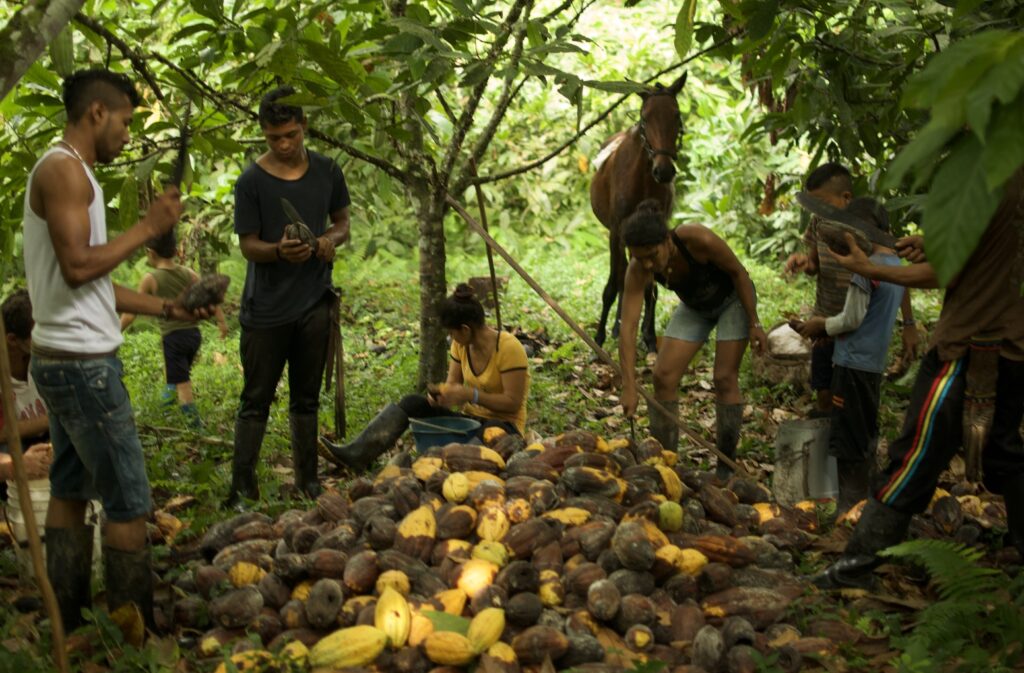Global civil society can support peace-building in conflict areas around the world by buying and promoting cocoa produced by grassroots communities working for peace and social justice.
Many places where cocoa is produced are affected by violence – either the direct violence of war, or the structural violence of poverty and marginalization.
Those who enjoy the relative security of the global north may think of such places as comfortingly remote from their everyday lives. Yet the fact is that even residents of the global north are intimately connected to the people who produce their food. They are thus indirectly implicated in the violence of such places.
Yet everyone can choose to contribute to local peace-building efforts, regardless of where they live. Often, in the darkest corners of the world, where people have suffered unbelievable atrocities, there are astonishing examples of humanity, love, creativity, and solidarity, which can serve as inspiration for us all.
Some of these people are cocoa farmers.
The Peace Community of San José de Apartadó are rural farmers in the war-torn region of Urabá in northwest Colombia. Trapped between left-wing guerrillas, right-wing paramilitaries, and state armed forces, they declared themselves neutral to the country’s 50-year armed conflict in 1997, as a self-protection strategy. Despite massacres, multiple forced displacements, torture, death threats, forced disappearances, and selective assassinations of leaders and even children, they have stubbornly and staunchly remained on their land.
In addition to their human rights work, the Peace Community also produces organic and fair-trade cocoa. They sell up to 100 tonnes per year to British multinational Lush Cosmetics, which uses their cocoa butter in products sold in 1000 shops in 50 countries, and helps raise awareness about the Peace Community’s human rights situation.
Cocoa plays a central role in the Peace Community’s local conception of peace. In the words of one member, “We strive for something alternative. As we say, a life path which builds peace. In the Community, it is our life for our brother. Where there is death, we sow life.”
Amid multiple attempts in Colombia to broker peace nationally, the Peace Community’s grassroots understanding of peace is a source of inspiration: it goes beyond the absence of violence, evoking solidarity economics, community labor and living, relationship with nature, social justice, and historical memory of the conflict. Ultimately, these principles could offer hope and inspiration to people around the world.
Experiences such as the Peace Community’s invite us to rethink our relationship with food; to value the efforts of those who produce it, their knowledge, struggles, and ideas; and to build bridges between victims of all types of violence and global civil society – for example, searching out cocoa connected to peace-building initiatives.
Próximamente versión en español

Entry added: January 4, 2023
Verified on: September 14, 2023
Authored by
Gwen Burnyeat, Junior Research Fellow in Anthropology, Merton College, University of Oxford
Academic / University Faculty
References
Chocolate, Politics and Peace-Building: An Ethnography of the Peace Community of San José de Apartadó, Colombia, Gwen Burnyeat, Cham: Palgrave Macmillan, 2018 (accessed January 17, 2023)
“Colombia’s Unsung Heroes,” Gwen Burnyeat, The London School of Economics and Political Science (LSE) Latin America and Caribbean Blog, June 7, 2018 (accessed January 17, 2023)
Have a comment on this definition?
